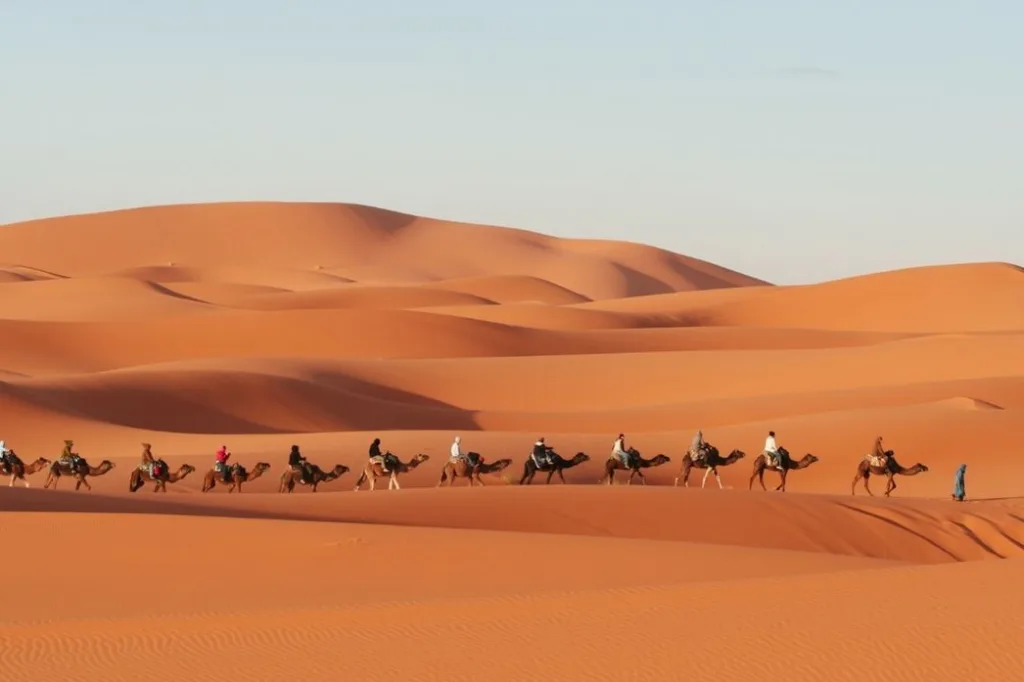Location & Continent
Continent: Africa
Country: Kenya
Coordinates: 2°S, 36°E
Physical Features
Area: ~15,000 km²
Elevation: Varies between 500–1,000 m
Notable Landforms: Sandy plains, scattered dunes, and seasonal dry riverbeds
Climate & Precipitation
Temperature: Hot and arid; daytime often exceeds 35–40°C
Precipitation: 150–300 mm annually; irregular and prone to drought
Ecological Features
Ecozone: East African arid and semi-arid lands
Biome: Deserts and xeric shrublands
Ecoregions: Part of the Kenyan Rift Valley arid ecosystems
Flora & Fauna
Flora: Acacia shrubs, thornbush, drought-resistant grasses
Fauna: Lions, elephants (from Amboseli and Tsavo), giraffes, zebras, antelopes, and small desert-adapted mammals
Geology & Notable Features
Geology: Semi-arid basin with sandy and volcanic soils
Notable Features: Lies between Amboseli, Tsavo West, and Nairobi National Parks; also called Taru Desert
Overview of the Nyiri Desert
The Nyiri Desert is a unique and captivating arid region located in Kenya. It is an expansive area that showcases the enchanting beauty of African deserts. Covering part of the Kajiado County, the Nyiri Desert is characterized by its vast sandy landscapes and distinctive flora and fauna.
Geographical Features
Spanning approximately 5,000 square kilometers, the Nyiri Desert is bordered by the magnificent Chyulu Hills to the southeast and the renowned Tsavo National Park to the east. The desert exhibits a fascinating mix of sandy soils and rocky outcrops.
Climate
The climate of the Nyiri Desert is predominantly semi-arid, with annual rainfall ranging from 200 mm to 600 mm. The temperatures can reach as high as 38°C (100°F) during the day and drop to 18°C (64°F) at night. This drastic temperature variation contributes to the desert’s unique ecosystem.
Flora and Fauna
The biodiversity in the Nyiri Desert is striking, despite the harsh conditions. The desert supports various forms of vegetation, primarily acacia trees, grasses, and succulents. Wildlife such as zebras, giraffes, and various species of antelopes can also be found thriving in this arid environment.
Comparison: Nyiri Desert vs. Other African Deserts
To provide a clearer perspective on the Nyiri Desert, let’s compare it with two other significant African deserts: the Sahara Desert and the Kalahari Desert.
| Feature | Nyiri Desert | Sahara Desert | Kalahari Desert |
|---|---|---|---|
| Location | Kajiado County, Kenya | Northern Africa | Southern Africa |
| Area | 5,000 km² | 9,200,000 km² | 900,000 km² |
| Average Rainfall | 200-600 mm | 100-250 mm | 200-500 mm |
| Prominent Vegetation | Acacia trees, grasses | Cacti, sand dunes | Grasslands, shrubs |
| Common Wildlife | Zebras, giraffes | Camels, foxes | Lions, elephants |
Cultural Significance
The Nyiri Desert is not just a natural wonder; it also holds great cultural significance for local Maasai communities who have inhabited the region for centuries. Their rich traditions and practices are closely tied to the land, reflecting a deep connection to the natural environment.
Tourism and Conservation Efforts
The stunning landscapes of Nyiri Desert attract eco-tourism, offering opportunities for photography, wildlife watching, and cultural experiences. Conservation efforts are underway to protect the delicate ecosystem and the traditions of the Maasai people, fostering sustainable tourism practices that benefit both the environment and local communities.
Conclusion
In summary, the Nyiri Desert stands out due to its rich biodiversity, cultural significance, and striking geographical features. This unique desert represents a vital part of Kenya’s natural heritage and ecology, demonstrating that even the harshest environments can support a variety of life. Efforts to preserve this magnificent landscape are crucial for future generations to explore and appreciate its beauty.


